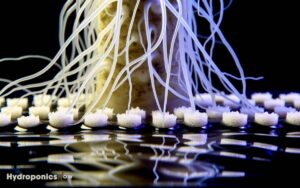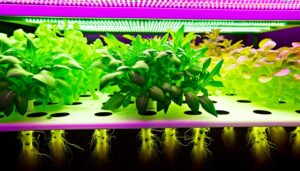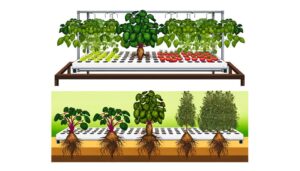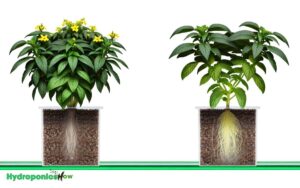10 Steps to Grow Hydroponic Plants in Mason Jars
Growing hydroponic plants in Mason jars entails selecting 1-2 liter jars made of glass or food-grade plastic to prevent chemical leaching. Use opaque jars or cover them to inhibit light and algal growth.
Opt for plants with compact root systems like leafy greens, herbs, or strawberries. Fill sterilized jars with specialized nutrient solutions and suitable growing mediums such as perlite or coconut coir.
Ascertain proper aeration using air pumps with air stones. Maintain nutrient and pH levels precisely, and provide 14-16 hours of full-spectrum LED light daily.
Regular monitoring of these parameters will lead to successful hydroponic gardening in jars – discover further details in the subsequent sections.
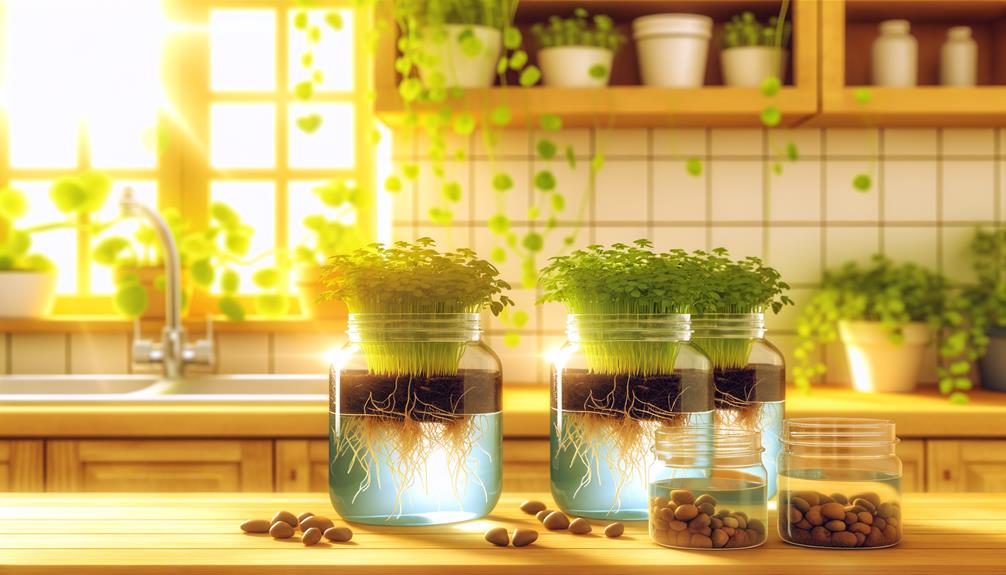
Key Takeaways
- Choose 1-2 liter opaque Mason jars to prevent algal growth and ensure root health.
- Use sterilized jars with nutrient solutions and growing mediums like perlite or coconut coir.
- Select plants with compact root systems, such as leafy greens, herbs, or strawberries.
- Maintain nutrient solution pH between 5.5-6.5 and EC between 1.2-2.0 mS/cm.
Choosing the Right Jars
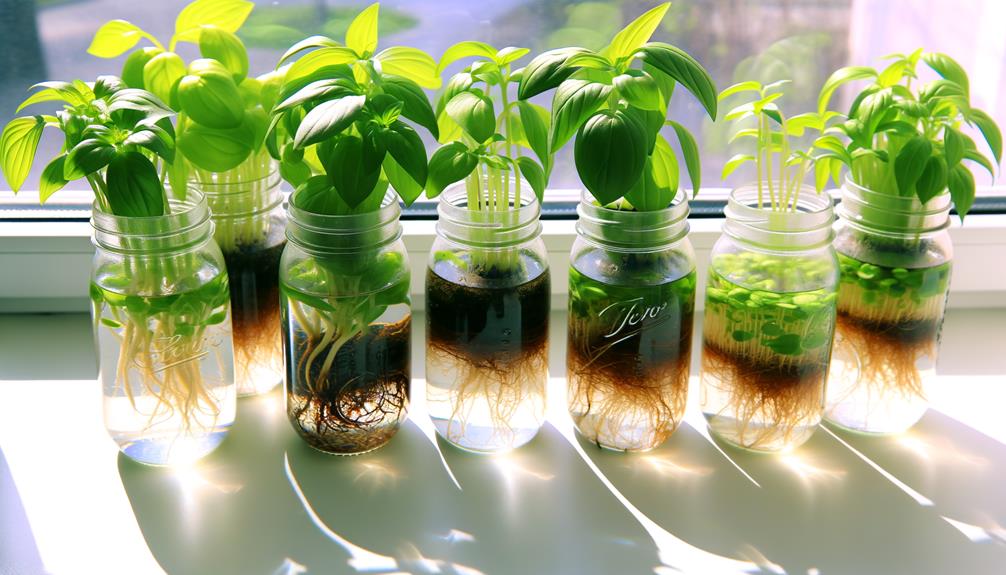
Selecting the appropriate jars for hydroponic cultivation is vital, as the size, material, and opacity of the containers directly impact root health, water retention, and light exposure.
Ideally, choose jars made of glass or food-grade plastic to prevent chemical leaching. The volume should be sufficient to accommodate root growth and maintain nutrient solution levels, typically around 1-2 liters.
Opaque jars or jars wrapped in light-blocking materials are recommended to inhibit algal growth, which competes for nutrients. Make sure the jar’s mouth is wide enough to support net pots while providing adequate airflow.
Proper jar selection minimizes root stress, optimizes nutrient uptake, and guarantees a stable environment, pivotal for successful hydroponic plant development.
Selecting Suitable Plants
Determining the best plant species for hydroponic systems involves evaluating factors such as growth habits, root structures, and nutrient requirements to guarantee compatibility with the chosen hydroponic setup. Leafy greens, herbs, and certain vegetables are ideal candidates due to their manageable size and nutrient uptake efficiency. Plants should exhibit compact root systems to avoid overcrowding in the limited space of Mason jars. Additionally, selecting plants that thrive in water-based environments ensures optimal growth and productivity. For example, growers can plant hydroponic strawberries easily by providing adequate nutrients and supporting their root systems within the confined space. Proper monitoring of water quality and nutrient balance further enhances plant health and yield in hydroponic systems.
| Plant Type | Growth Habit | Nutrient Demand |
|---|---|---|
| Leafy Greens | Compact & Upright | Moderate |
| Herbs | Bushy | Low to Moderate |
| Lettuce | Rosette-forming | Moderate |
| Spinach | Low & Spreading | Moderate |
| Strawberries | Clumping | High |
Proper selection guarantees ideal growth and resource utilization in Mason jar hydroponics, enhancing overall plant health and yield.
Setting Up the Hydroponic System
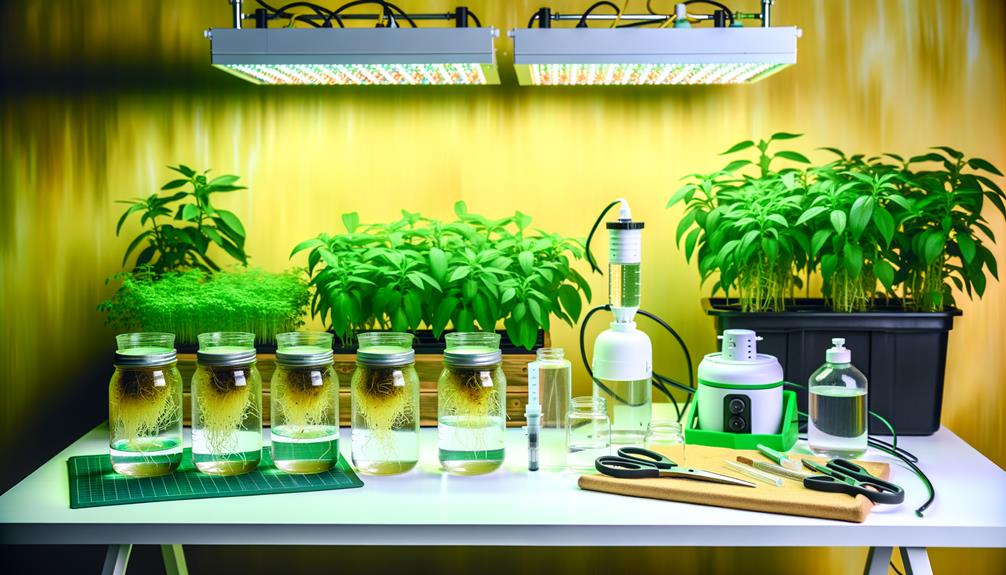
To establish a functional hydroponic system, it is essential to select an appropriate container, nutrient solution, and growing medium while ensuring adequate light and oxygen supply for ideal plant growth.
Begin by choosing Mason jars as the primary containers, ensuring they are sterilized to prevent contamination.
Fill each jar with a nutrient solution that matches the specific requirements of the plants being cultivated.
For the growing medium, use materials such as perlite, vermiculite, or coconut coir, which facilitate root aeration and moisture retention.
Secure net pots within the jar openings to support plant roots.
Implement an air pump with air stones to oxygenate the nutrient solution, thereby preventing root hypoxia and promoting robust growth.
Providing Nutrients and Light
Ensuring the ideal growth of hydroponic plants necessitates the meticulous provision of a balanced nutrient solution in conjunction with controlled lighting conditions.
Begin by selecting a hydroponic nutrient mix comprising macronutrients (N, P, K) and essential micronutrients (Fe, Mn, Zn, Cu). Dissolve the nutrient solution in water, maintaining an advantageous Electrical Conductivity (EC) of 1.2-2.0 mS/cm, and monitor pH levels, ensuring they remain between 5.5-6.5 for nutrient absorption.
Lighting is critical; employ full-spectrum LED grow lights to mimic natural sunlight. Position lights 6-12 inches above the plants, providing 14-16 hours of illumination daily. Adjust light intensity and distance to avoid photoinhibition or etiolation.
Combining these practices will foster robust hydroponic plant growth.
Maintaining Your Hydroponic Garden
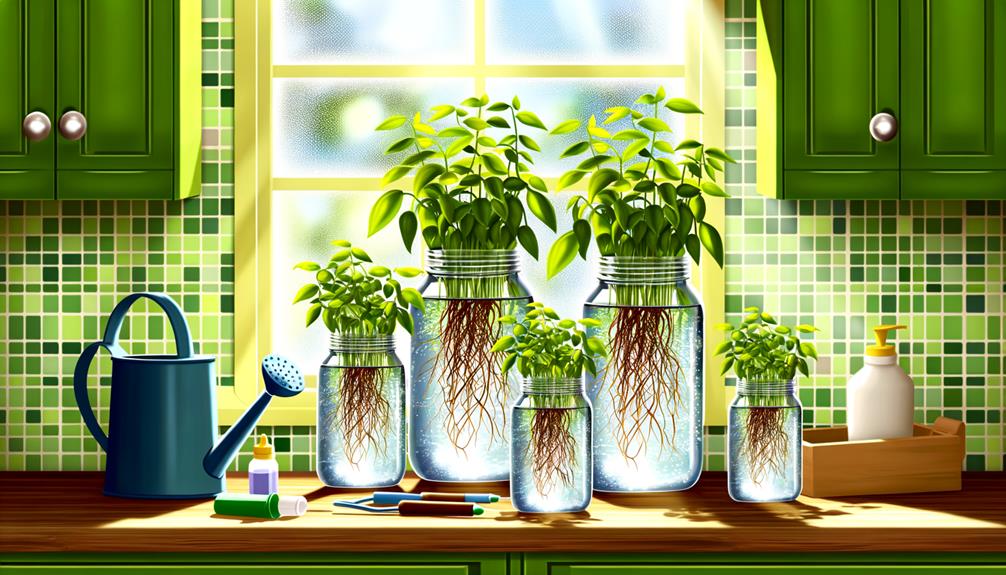
Maintaining your hydroponic garden involves regularly monitoring and adjusting the nutrient solution, pH levels, and environmental conditions to guarantee excellent plant health and growth. Confirm the nutrient solution is refreshed biweekly to prevent nutrient imbalances and pathogen proliferation. Use a pH meter to maintain the solution within the best range of 5.5-6.5. Environmental factors, such as light intensity and temperature, should be controlled using appropriate grow lights and ventilation systems.
| Task | Frequency |
|---|---|
| Check pH levels | Daily |
| Replace nutrients | Every 2 weeks |
| Inspect root health | Weekly |
| Adjust lighting | As needed |
Regularly inspecting root systems for signs of disease and confirming plants receive 14-16 hours of light daily are critical for thriving hydroponic growth.
Conclusion
In summary, selecting appropriate mason jars, choosing suitable plant species, meticulously setting up the hydroponic system, guaranteeing adequate nutrient and light provision, and diligently maintaining the hydroponic garden are fundamental steps to successful hydroponic cultivation in mason jars.
Adhering to these critical elements guarantees peak plant growth, maximizes resource efficiency, and promotes a sustainable gardening practice.
Employing scientific principles and technical precision in each phase assures a thriving and productive hydroponic garden.

